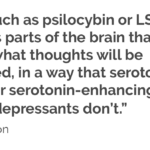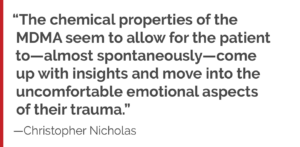
Innovative research on psychedelics is offering new hope for treating difficult psychiatric conditions where few options exist
by Jill Sakai
From the outside, the door is completely unremarkable, like a hundred others in Rennebohm Hall. Step through it, though, and it takes you into a research facility unlike any other at the University of Wisconsin–Madison—or at most other universities.
Inside, the room looks more like a living room than a clinical treatment space. A long sectional couch rests upon a Persian-style rug. Facing it, a pair of cushy armchairs bookend a small table holding a reading light and a bowl of dark chocolates. Colorful prints adorn the walls and the space is filled with the warm glow of a few well-placed lamps. You could almost overlook the folding cot against one wall and the portable medical monitor tucked behind the couch.
This unusual space is helping Paul Hutson explore innovative treatments for serious mental health challenges.
Hutson, a professor in the University of Wisconsin–Madison School of Pharmacy’s Pharmacy Practice Division, is part of a team of UW–Madison researchers who are studying the unique properties of psychedelic compounds and their potential to treat post-traumatic stress disorder (PTSD), depression, substance use disorders (formerly termed “addictions”), and more.
As evidence mounts to suggest that psychedelic drugs might lessen symptoms of trauma, depression, anxiety, and substance abuse, researchers hope that these agents may finally bring relief to some people suffering from a range of devastating mental disorders.
Within the right setting, Hutson says, “The results from modern research studies suggest that there’s a therapeutic benefit, for many people, in allowing them to have important insights about their life through the experiences elicited by these drugs.”
Off the sidelines
Psychedelics such as LSD and psilocybin, the active compound in hallucinogenic mushrooms, were outlawed in the United States in the late 1960s, spurred largely by concerns about recreational abuse. MDMA, the main active ingredient in the recreational drug ecstasy, was similarly banned in 1985. Their classification by the Drug Enforcement Administration as Schedule I controlled substances subjects them to strict regulations that put them out of reach even for most research.
But prior to being banned, several studies had hinted that these psychoactive agents might help treat a variety of mental conditions. During the past decade, a few teams of researchers—largely supported by non-profits such as the Multidisciplinary Association for Psychedelic Studies (MAPS), the Heffter Research Institute, and the Madison-based Usona Institute—have begun revisiting those ideas, with promising early results.

Similarly, a recent series of phase 2 trials that added MDMA to psychotherapy treatment for PTSD showed such promising benefits that MDMA received breakthrough status in 2017, paving the way forward for larger studies and possible drug approval.
Now, UW–Madison is one of several sites across the U.S., Canada, and Israel enrolling PTSD patients in a placebo-controlled phase 3 trial of MDMA-assisted psychotherapy. The Madison research team will also be part of a multi-site clinical trial of psilocybin for treating depression that aims to support a new drug application to the FDA.
Safety first
This isn’t the Madison team’s first foray into psychedelics research. A few years ago, Hutson led a study to better understand how high doses of psilocybin are broken down in healthy individuals. The expertise and resources developed through that work have positioned the School of Pharmacy and Hutson’s collaborators at the UW–Madison as one of the few academic institutions and groups prepared to study psychedelics safely.
That emphasis on safety is crucial, says Hutson. A psychedelic experience in a clinical trial bears no resemblance to recreational drug use. Potential participants undergo intensive screening to ensure they can go through the study treatment without harm. They receive hours of counseling and other preparation that might include setting goals or defining ways to communicate while in an altered state. And if enrolled, patients receive a known concentration of a pure form of the drug and remain within a very controlled setting for the duration of the treatment. They typically receive no more than one to three doses, approximately a month apart, and always under observation and the supervision of a physician. In the Madison program, Randall Brown, an associate professor in the Department of Family Medicine and Community Health in the UW–Madison School of Medicine and Public Health, is the medical supervisor.

With psilocybin, each participant is accompanied at all times during their psychedelic experience by two trained “guides” or “facilitators.” In the ongoing study of MDMA-assisted psychotherapy for patients with PTSD, Madison-based participants will be joined throughout the dosing session by therapists who are clinical psychologists and who provide the psychotherapy portion of the treatment.
The therapists help patients feel safe to explore aspects of their trauma while connecting to the thoughts and feelings that arise, says Christopher Nicholas, the principal investigator for the MDMA-assisted psychotherapy study for PTSD and an assistant professor in the Department of Family Medicine and Community Health.
The guides can also provide emotional support, especially if a patient encounters a psychologically challenging moment during the session. Sometimes a person in this state could encounter a frightening or intimidating image or object, such as a monster, or a whirlpool trying to suck them down—things that may be rife with personal meaning and metaphor. Or patients may report feeling threatened, anxious, or trapped, Hutson says. “You’re dealing with images and often meaningful expressions of things that your brain is trying to grapple with.”
Enhancing connections
PTSD often manifests as “someone feeling stuck in a fixed pattern around their experience, around themselves, around the way they see the world,” explains Chantelle Thomas, a clinical psychologist involved in the UW–Madison studies.
A person’s instinctive response is typically to avoid memories or feelings connected to the trauma. As a result, several traditional trauma-based therapies generally encourage patients to overcome those patterns by repeatedly moving “into the most intense and difficult parts of their trauma as a way to help them heal,” Thomas says. “It asks a lot of the client in order to get better.” Partly as a result, therapy dropout rates are high.
In psychedelic-assisted psychotherapy the therapist’s goal is to facilitate an inner-directed experience for the patient, Nicholas says. “The chemical properties of the MDMA seem to allow for the patient to—almost spontaneously—come up with insights and move into the uncomfortable emotional aspects of their trauma,” he says. That self-directed process can feel gentler and places strong emphasis on tapping into one’s innate wisdom and ability to heal—an especially powerful message for trauma patients, many of whom feel broken, ashamed, or even defective, Thomas says.
Another hallmark of those who suffer from PTSD is “feeling very trapped in their own experience and isolated from others,” she says. “People heal through relationships, and often the biggest barrier is the inability to feel connected to themselves and to other people.”
In that regard, MDMA offers a unique promise: It boosts the release of “pro-social” hormones such as oxytocin, which may enhance psychotherapy’s benefit. “The real hope for this is that it’s not just people addressing their trauma differently, it’s that their relationship with themselves completely evolves,” Thomas says.
“MDMA seems to scaffold the relationship between the therapist and the patient in a way that allows the patient to really feel safe and secure enough to move into the challenging thoughts, feelings, and memories associated with their trauma,” Nicholas says. “The properties of the drug, interacting with the strength of the relationship with the therapist, seems to break down enough of those barriers that typically get in our way of connecting to whatever part of ourselves could allow us to heal.”
And it seems to accelerate the process. The types of insights that arise in one or two MDMA-assisted sessions might take a year or more to emerge in traditional outpatient therapy.
Unbounded brains
It still isn’t exactly clear how these drugs work in the brain. MDMA and psilocybin both affect serotonin receptors in the brain, and MDMA interacts with dopamine and norepinephrine receptors as well. But understanding how those chemical interactions translate into psychological effects is harder, Hutson says.
“There’s something about the balance of the receptors that they’re acting upon that elicits a different response than, say, serotonin acting on the same receptor,” Hutson says. “Drugs such as psilocybin or LSD suppress parts of the brain that control what thoughts will be processed, in a way that serotonin and other serotonin-enhancing drugs like antidepressants don’t.”
Early results of brain imaging studies show that psilocybin alters patterns of brain activity and connectivity.
“The brain becomes far more interconnected when one is on a psychedelic,” Hutson says. “The communication between various parts of the brain is intensified and expanded.”
Those include brain regions involved in emotional regulation, memory, and cognitive processing. It’s tempting to speculate that such changes could reflect a rewiring process that helps a patient’s brain break out of its harmful patterns of thoughts and feeling, but it’s far too early to know, Hutson cautions.
A recent imaging study from Imperial College London—one of the only to compare brain activity before and after a psychedelic treatment—identified activity changes after psilocybin that correlated with improvement in depression symptoms. What’s more, some of the observed brain changes persisted for weeks—and in some cases, months—after just one therapeutic dose.
A new vista
That potential for lasting change, which emerged from behavioral and psychiatric data in earlier studies as well, is highly compelling. A psychedelic’s chemical effect is basically gone within eight hours, Hutson says. Beyond that, any effects likely come from how the patient moves forward and builds upon their experience.
“Both of these drugs allow you to look out of a door on a view that you’ve never seen before,” he says. “At some point, the door closes and you no longer can see that vision. But you have insight about what you experienced, and you can think and talk about how that affects the issues that you’re dealing with.”
During an integration phase the morning after the dosing session, the guides or therapists continue to help patients process their experience, reflect on any insights that emerged, or identify steps to address challenges that arose during the treatment.
There’s still a lot of uncharted territory. The MDMA-assisted psychotherapy study for PTSD is now underway, and the UW–Madison team is developing studies to explore psilocybin as a treatment for severe depression, opioid use disorder, and methamphetamine use disorder. Study outcomes and whether the FDA subsequently approves the drugs as medical treatments will determine the future of the field. But if the results are positive, Hutson sees huge potential for helping large groups of people, with beneficial effects rippling out to societal health measures, prisons, health care costs, and the economy.
And it’s exciting to be on the cusp of something that offers new hope for troubled patients.
“A trauma that leads to PTSD—an IED [improvised explosive device], rape, or coming upon an accident as a first responder—happens in moments, seconds, minutes. And something in that traumatic event fundamentally changes your brain’s processing of things in virtually an instant,” Hutson says.
“Just as remarkably, something is happening in that six to eight hours of supervised treatment, whether it is the psilocybin or the MDMA. Something happens that allows some subjects to open up, process, rearrange their goals and expectations, their understanding of themselves,” he adds.
“So maybe it’s not so fantastical that six hours under the influence of one of these drugs could allow the brain to fix itself a bit.”
Read a Washington Post article about psilocybin research, featuring Professor Paul Hutson’s expertise.





